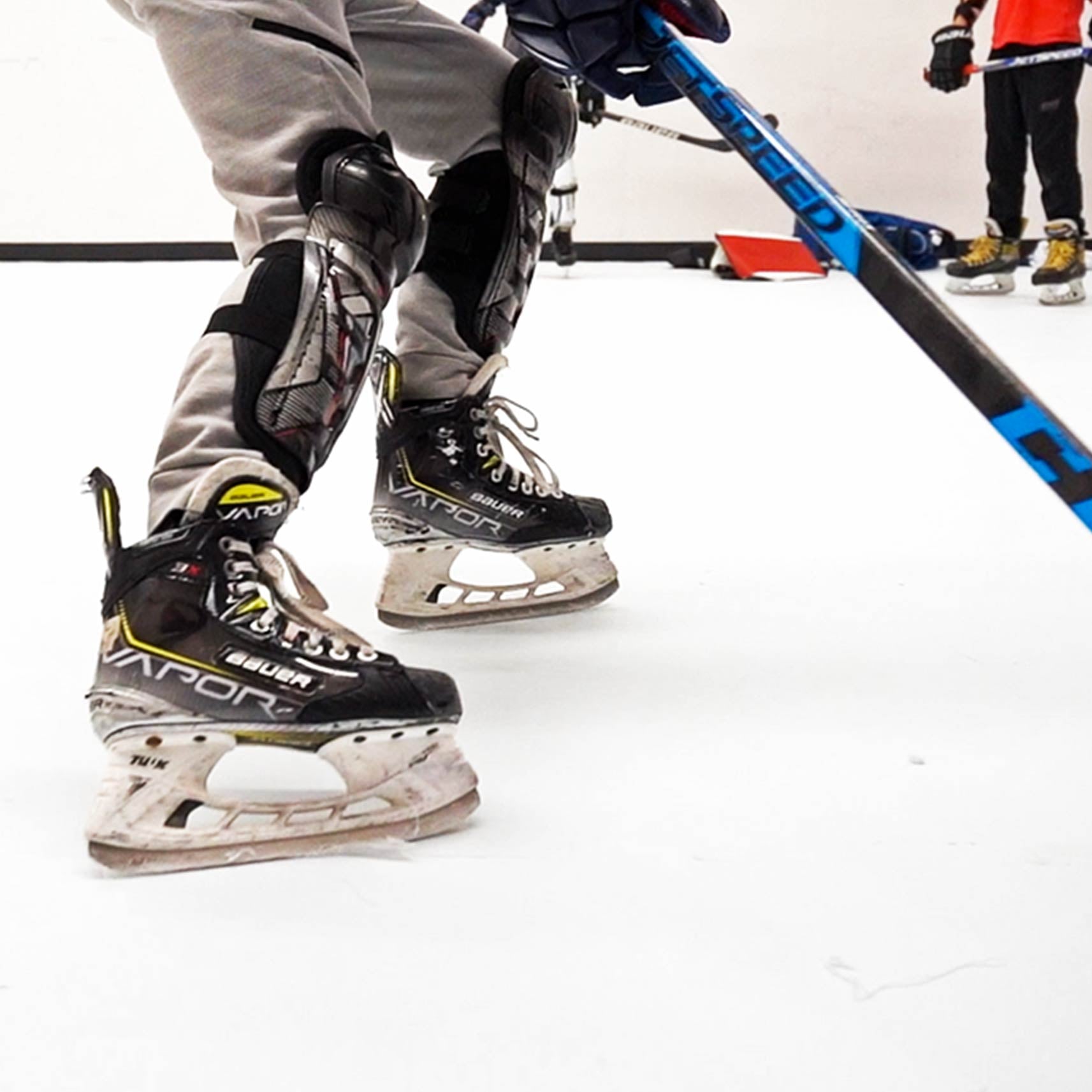Skateable synthetic ice has become one of our top-selling products over the years. This highly-engineered slick surface is designed to support movement on skate blades for thousands of hours of hockey training, whether used indoor or outdoor.
One of the interesting things we’ve learned from our synthetic ice customers over time, however, is how many purchase the product not for at-home skating…but rather to allow their players to train other off-ice skills at home while wearing skates.
After consulting with many customers and training professionals, here are the three most common reasons why at-home training with synthetic ice is beneficial.
1. Training in skates simulates game height. The distance from the bottom of one’s skate boot to the bottom of the blade is 2-3”, meaning that a player becomes 2-3” taller while wearing skates! This is noteworthy for two reasons.
First, sticks are generally cut to accommodate one’s height while on skates, so using a stick designed for on-ice use will suddenly feel longer if used by that player without skates. If that player gets accustomed to dryland training with that “longer” stick, then they have to re-adjust when they return to the ice. 2-3” difference may not seem like much, but consider all the work on fine motor skills and precision puck handling, or even release points and stick flex while shooting. Those 2-3" is the difference between strong contact and a whiff. A second, and related reason is that a player’s eyes are 2-3” further away from the puck while wearing skates compared to wearing shoes, so the best way to build that hand-eye coordination with puckhandling skills and muscle memory is to train while at game height.
Note: some players get around this by simply using a different length of stick for dryland practice to calibrate to ice-like environment. It’s a legit alternative, but if given the choice, we prefer training at home on skates from our perspective.
2. Movement. Hockey is a game played on the move, with frequent changes of direction. The ability to stickhandle, pass or shoot while going forward, backward, or laterally is also critical to one’s development. And as part of this, the legs are being taught to work independently from the eyes and hands, which requires both physical and mental collaboration. Therefore a player can train those skills at home while also moving will be better equipped when back on the ice. Further, weight transfer, posture and balance also play a major role as skills as performed, and wearing one’s skills while training helps to reinforce those good habits.
3. Balance, ankle and leg strength. Moving or skating on synthetic ice does take some getting used to, including that it requires a stronger push by the skater to create the same amount of glide. The good news is that this extra effort translates into building stronger skating muscles, that will then translate into faster skating when back on real ice. Next, consider how much of skating practice emphasizes edge work and comfort with moving and performing other actions while standing on a thin skate blade, and doing off-ice skills training while on skates would reinforce that balance as well. Lastly, more time in skates helps a player develop those micro-muscles in the ankles that are great for stability and strength, that simply training in wide sole shoes are unable to provide.
All that said, of course synthetic ice is great for skating experience as well! Especially for players who are learning to skate, as skating on synthetic ice is great basic encouragement of balance, edge work, stopping, push offs, small area movements, and more. And for families with the means to invest in a considerable-sized skating area, their players will also love it.
Another takeaway from our customers’ feedback is that even one box of synthetic ice panels is enough to help with your player’s development.
Each box of Snipers Edge synthetic ice comes with four panels that are each just under 24” x 48”, or 29 of SF when fully assembled. With that one box, a player has a platform from which to shoot pucks while wearing skates, can push forward with their back foot, practice one-leg shots, and/or focus on weight transfer. The platform can be positioned 10-15 from in front of the net, or moved in even closer to practice in-tight shots. If assembled as a square, this size also allows for in-front stickhandling for players of all ages such as figure-8s or out-wide to one direction. Or, the panels can be assembled in a continuous row for down-and-back stickhandling around pucks or cones. One box is also enough for beginning skaters to get comfortable on skates, build ankle strength, and start with some basic movements.
When more boxes are added, the training area becomes even more versatile! A player with a larger training area can now move in multiple different directions, set up a U-shaped configuration or larger square to practice stickhandling behind one’s body, create multiple platforms for saucering passes to and from, set up a small area obstacle course, and much more. More boxes requires a more-sizable investment, of course, but fortunately the panels are designed to connect to other boxes and therefore the training area can expand over time as a family may desire.
As you can tell, there is more to training with synthetic ice than initially meets the eye, and we’re grateful for the valuable feedback from our customers and training center partners about how synthetic ice has helped elevate their game.
Whatever skills your player is looking to improve upon and whatever your budget, Snipers Edge Hockey has the hockey flooring and training products to help you get there.


